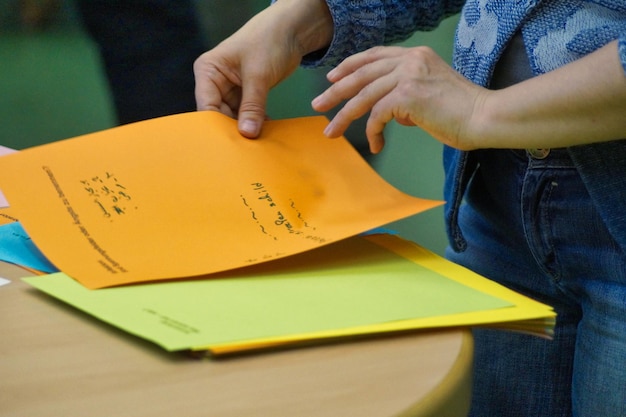IEP Process: A Practical Guide for Students with Disabilities

IEP (Individualized Education Program) is a crucial process for students with disabilities in the US, ensuring they receive tailored educational support and services to meet their unique needs.
Navigating the educational system can be challenging, especially for parents of children with disabilities; understanding the IEP (Individualized Education Program) process for students with disabilities is essential to advocate for their needs. This practical guide will help you through each step of the IEP journey.
What is an IEP?
An Individualized Education Program (IEP) is a legally binding document created for students with disabilities who require specialized instruction. It outlines the specific goals, services, and support the school district will provide to help the student succeed academically.
The IEP is designed to address the unique needs of each student and create a personalized learning environment. Understanding the components of an IEP is the first step in ensuring your child receives the appropriate educational support.
Key Components of an IEP
An IEP includes several essential elements that collectively create a roadmap for the student’s educational journey. Some of the main components are:
- Present Levels of Performance: A summary of the student’s current academic and functional performance, including strengths and areas needing improvement.
- Measurable Annual Goals: Specific, measurable, achievable, relevant, and time-bound (SMART) goals that the student is expected to achieve within one year.
- Special Education and Related Services: A description of the special education and related services, such as speech therapy, occupational therapy, or counseling, that the student will receive.
- Accommodations and Modifications: Adjustments to the learning environment, instructional methods, or assessment procedures that enable the student to access the curriculum and demonstrate their knowledge.
Furthermore, the IEP process emphasizes collaboration among educators, parents, and sometimes the student themselves. This collaborative approach ensures that the IEP is tailored to the individual’s needs and reflects a shared understanding of their strengths and challenges.
In summary, an IEP is a critical tool for supporting students with disabilities. It provides a framework for individualized instruction, related services, and accommodations, all designed to help students achieve their full potential.
Who is Involved in the IEP Process?
The IEP process involves a multidisciplinary team dedicated to supporting the student’s educational journey; understanding the roles and responsibilities of each member is crucial. Parents play a vital role, providing insights into their child’s strengths, needs, and learning style.
Collaboration among team members ensures that the IEP is comprehensive and tailored to the student’s unique requirements. The IEP team typically includes:
- Parents or Guardians: Active participants who provide valuable input on their child’s needs and goals.
- Special Education Teacher: A teacher certified to provide specialized instruction to students with disabilities.
- General Education Teacher: A teacher who provides instruction in the regular classroom setting and collaborates with the special education teacher.
- School Psychologist: An individual who assesses the student’s cognitive, academic, and social-emotional functioning.
- School Administrator: A representative of the school district who ensures that the IEP is implemented according to regulations.
In addition to these core members, the IEP team may also include related service providers such as speech therapists, occupational therapists, physical therapists, and counselors. These professionals offer specialized expertise and support to address the student’s specific needs.
The IEP team collaborates to review assessment data, set measurable goals, and determine the appropriate special education and related services. Regular communication among team members ensures that the IEP remains relevant and effective in meeting the student’s evolving needs.

Steps to Take Before the IEP Meeting
Preparing for an IEP meeting can significantly enhance its effectiveness. Parents play a pivotal role in advocating for their child’s educational needs. Understanding the steps to take beforehand ensures that they can actively participate and contribute to the development of a comprehensive IEP.
The advance preparation will help the IEP team create a plan that best serves the student’s individualized education requirements. It will also ensure that everyone can voice input:
Gather Relevant Information
Collect all pertinent information regarding your child’s academic performance, medical history, and any evaluations or assessments conducted. Have reports from teachers, therapists, and other professionals who have worked with your child. This information will serve as the foundation for discussions during the IEP meeting.
Create a List of Goals
Develop a list of specific, measurable, achievable, relevant, and time-bound (SMART) goals for your child’s education. What do you hope they will accomplish in the next year? Consider academic, social, and behavioral goals. Presenting these goals during the meeting will guide the team in formulating an effective IEP.
In conclusion, thorough preparation before the IEP meeting empowers parents to actively participate and advocate for their child’s educational needs. By gathering relevant information and formulating specific goals, parents can help ensure that the IEP is comprehensive, individualized, and aligned with their child’s unique needs and aspirations.
What to Expect During the IEP Meeting
Knowing what to expect during the IEP meeting can alleviate anxiety and empower parents to participate effectively. The meeting typically follows a structured agenda, beginning with introductions and a review of the student’s present levels of performance. This helps frame the discussion and ensures everyone is aware of the student’s current strengths and challenges.
Understanding the agenda and key discussion points empowers parents to voice their opinions and advocate for the child’s needs. During the IEP meeting, you can expect the team to:
Review Present Levels of Performance
The IEP team will review the student’s current academic and functional performance, including their strengths and areas needing improvement. This assessment is based on various sources, such as standardized tests, classroom observations, and parent input.
Develop Measurable Annual Goals
Collaboratively, the team will create specific, measurable, achievable, relevant, and time-bound (SMART) goals that the student is expected to achieve within one year. These goals should address the student’s unique needs and align with state academic standards.
Outline Special Education and Related Services
The IEP team will determine the appropriate special education and related services necessary to support the student’s progress toward their goals. These services may include specialized instruction, speech therapy, occupational therapy, counseling, and transportation.
To conclude, being informed about what to expect during the IEP meeting is essential for parents who want to take an active and influential role. By understanding the meeting’s agenda, key discussion points, and the roles of team members, parents can effectively voice their opinions, advocate for their child’s needs, and contribute to the development of a comprehensive and individualized IEP.

Implementing the IEP in the Classroom
Implementing and monitoring the IEP effectively in the classroom is critical to the success of students with disabilities; ensuring that the IEP is more than just a document is essential. It requires coordination and open communication among all educational staff involved.
To ensure that the students are receiving the support outlined in the IEP:
- Regular communication with the special education teacher
- Ensure that the general education teacher has a clear understanding of the student’s IEP goals, accommodations, and modifications.
- Foster collaboration between the special education teacher and the general education teacher to ensure that the student’s needs are met in both settings.
Monitoring Progress and Making Adjustments
Regular monitoring of the student’s progress toward their IEP goals is essential. Collect data on the student’s academic performance, behavior, and social-emotional well-being. Share this information with the IEP team to inform decision-making and make necessary adjustments to the IEP.
In summary, successful implementation of the IEP requires ongoing collaboration, communication, and monitoring. By ensuring that the IEP is effectively implemented in the classroom and by regularly monitoring the student’s progress, educators can maximize the student’s opportunities for success and promote their overall well-being.
Reviewing and Revising the IEP
The IEP is a living document that should be reviewed and revised periodically to ensure its continued relevance and effectiveness; understanding the process for reviewing and revising the IEP is crucial for maintaining a student’s educational progress.
IEP review and revision ensure that the student is getting the education and help that they need. Typically, the school district will conduct ongoing data collection, which is regularly reviewed:
- Conduct Regular Reviews: The IEP should be reviewed at least annually or more frequently if necessary. This review provides an opportunity to assess the student’s progress, address any emerging needs, and make adjustments to the IEP as needed.
- Incorporate Parent Input: Parents are essential members of the IEP team, and their input should be actively sought during the review and revision process. Consider their perspectives on their child’s progress, challenges, and goals.
- Make Data-Driven Decisions: Utilize data from various sources, such as assessments, observations, and classroom performance, to inform decision-making regarding IEP revisions. Ensure that revisions are based on evidence and align with the student’s current needs and goals.
As a conclusion, reviewing and revising the IEP ensures that the student’s educational plan remains relevant, effective, and responsive to their evolving needs. By conducting regular reviews, incorporating parent input, and making data-driven decisions, IEP teams can optimize the student’s opportunities for success and promote their overall well-being.
| Key Point | Brief Description |
|---|---|
| 📝 What is an IEP? | A legally binding document outlining educational support for students with disabilities. |
| 🤝 IEP Team | Includes parents, teachers, school psychologists, and administrators who collaborate on the IEP. |
| 🎯 Measurable Goals | Specific, achievable goals set for the student within one year. |
| 🔄 Regular Review | IEP should be reviewed annually to ensure it meets the student’s evolving needs. |
[FAQ about IEP]
▼
Students with disabilities who require specialized instruction and related services to access the general education curriculum are eligible for an IEP. Eligibility is determined through evaluations and assessments.
▼
IEP meetings are held at least once a year to review and revise the IEP. However, meetings can be convened more frequently if needed to address specific concerns or changes in the student’s needs.
▼
If you disagree with the IEP, you have the right to request mediation or file a complaint with the state education agency. It’s important to communicate your concerns and work collaboratively with the IEP team.
▼
Yes, the IEP can be changed during the year if the IEP team agrees that revisions are necessary. Parents have the right to request an IEP meeting to discuss potential changes and adjustments to the plan.
▼
Related services are supports that are required to assist a child with a disability to benefit from special education. Related services may include speech-language pathology, audiology services, interpreting services, psychological services, physical and occupational therapy, recreation, including therapeutic recreation, social work services, school nurse services designed to enable a child with a disability to receive a free appropriate public education as described in the individualized education program of the child, counseling services, including rehabilitation counseling, orientation and mobility services, and medical services for diagnostic or evaluation purposes.
Conclusion
Understanding the IEP process is essential for advocating effectively for students with disabilities. By actively participating in each step, from initial assessment to implementation and review, parents and educators can ensure that students receive the individualized support they need to thrive academically and reach their full potential.





